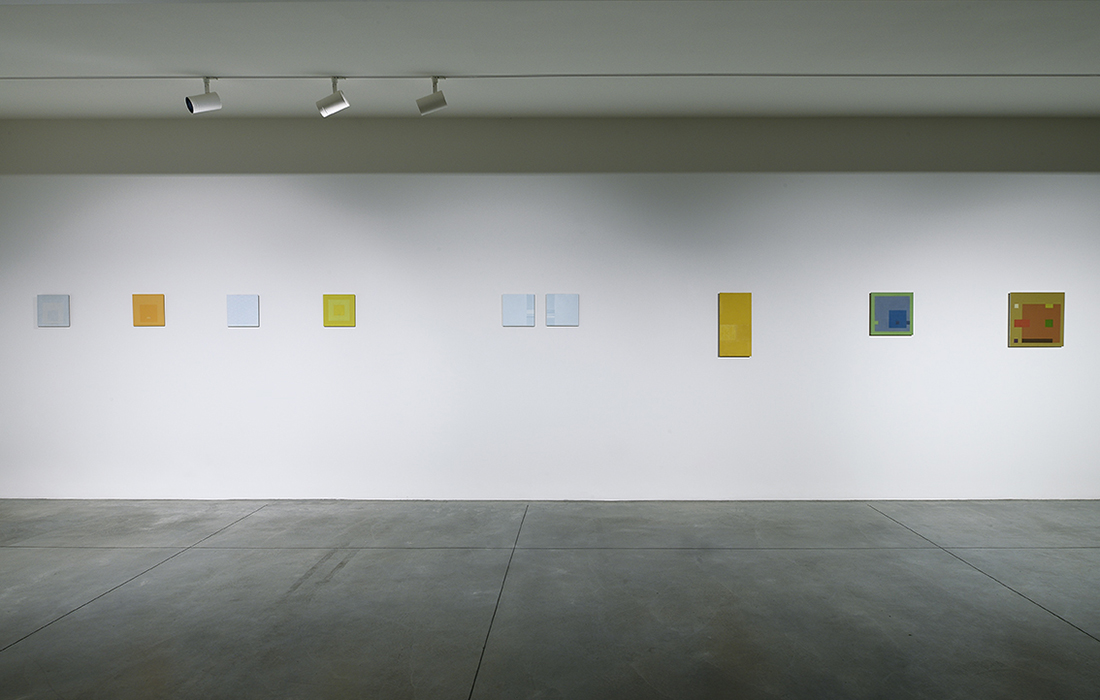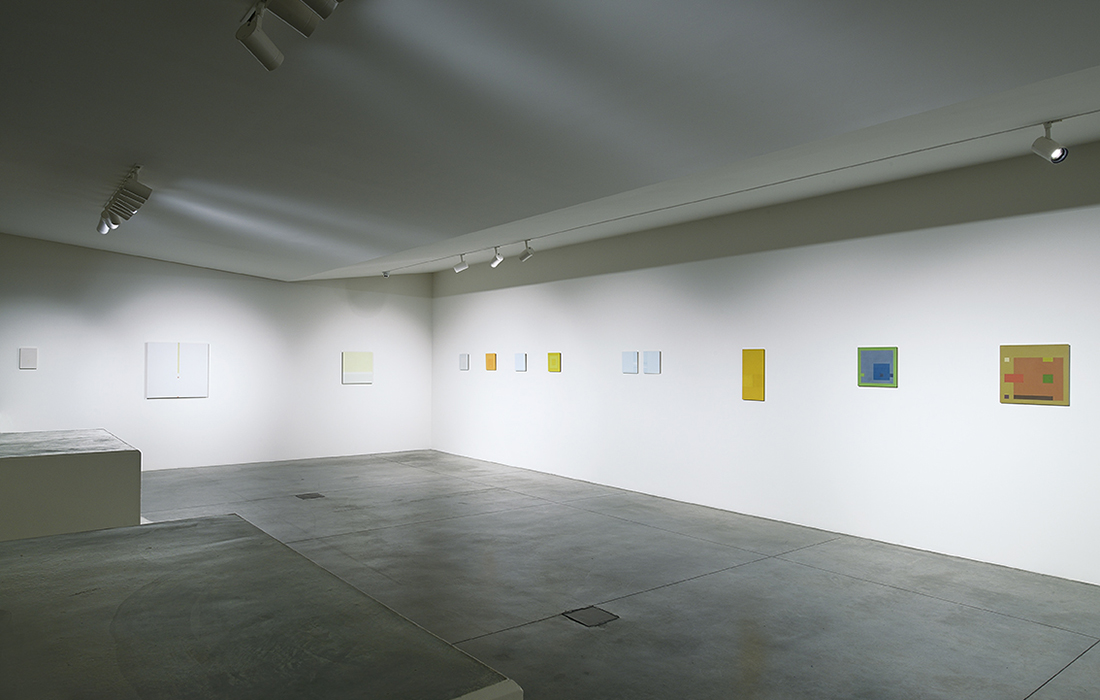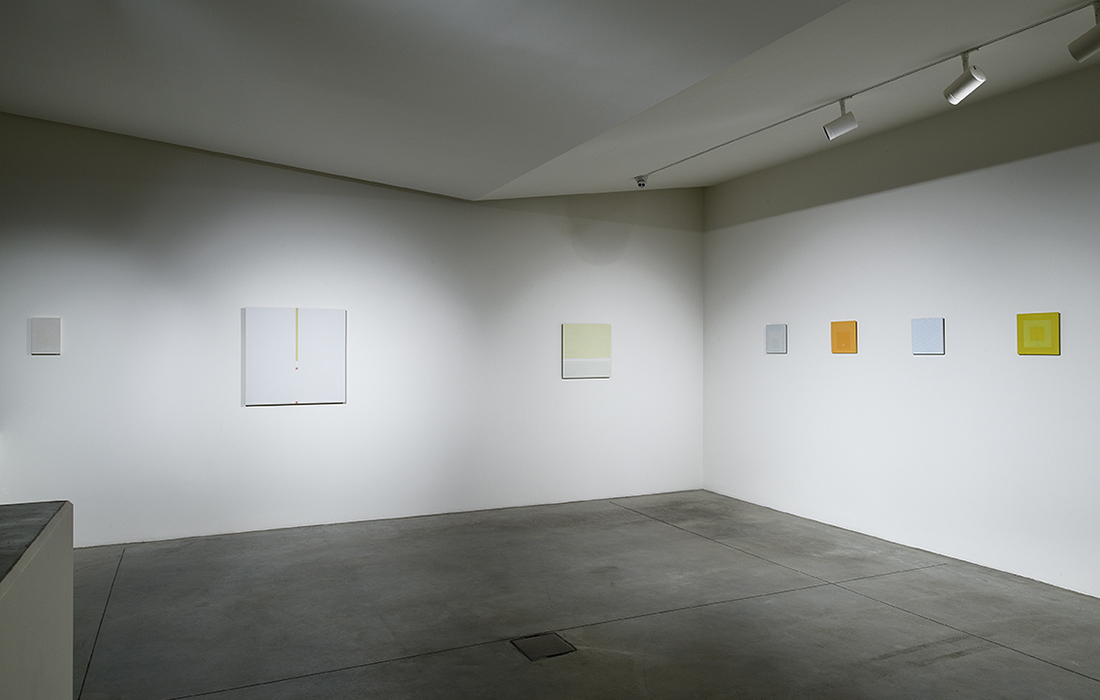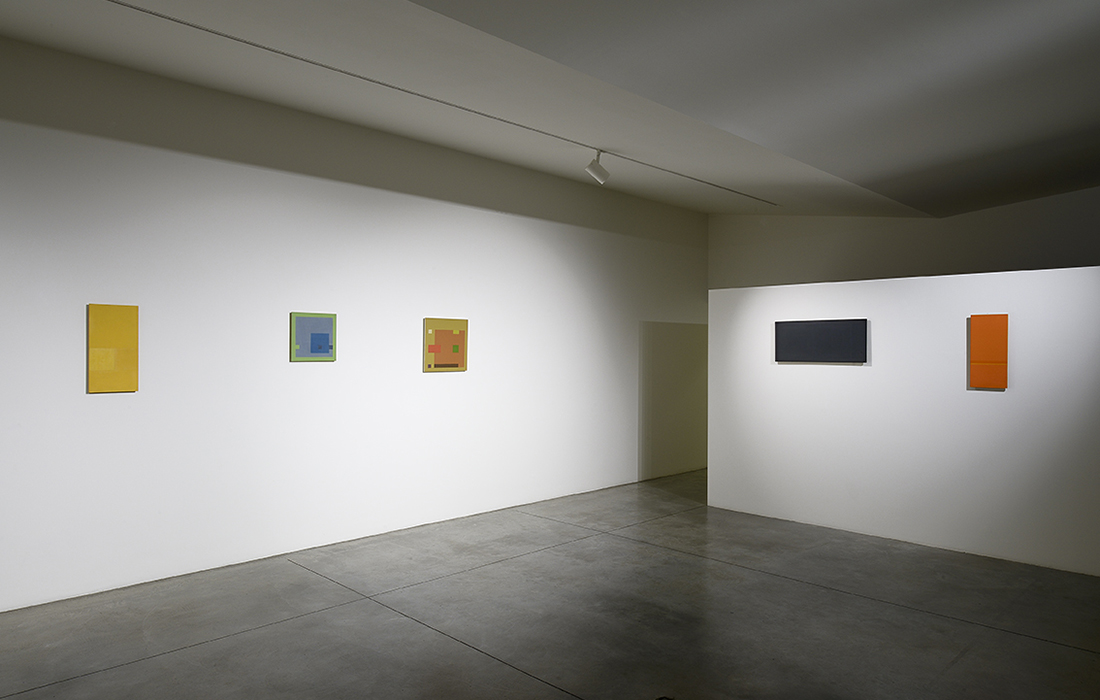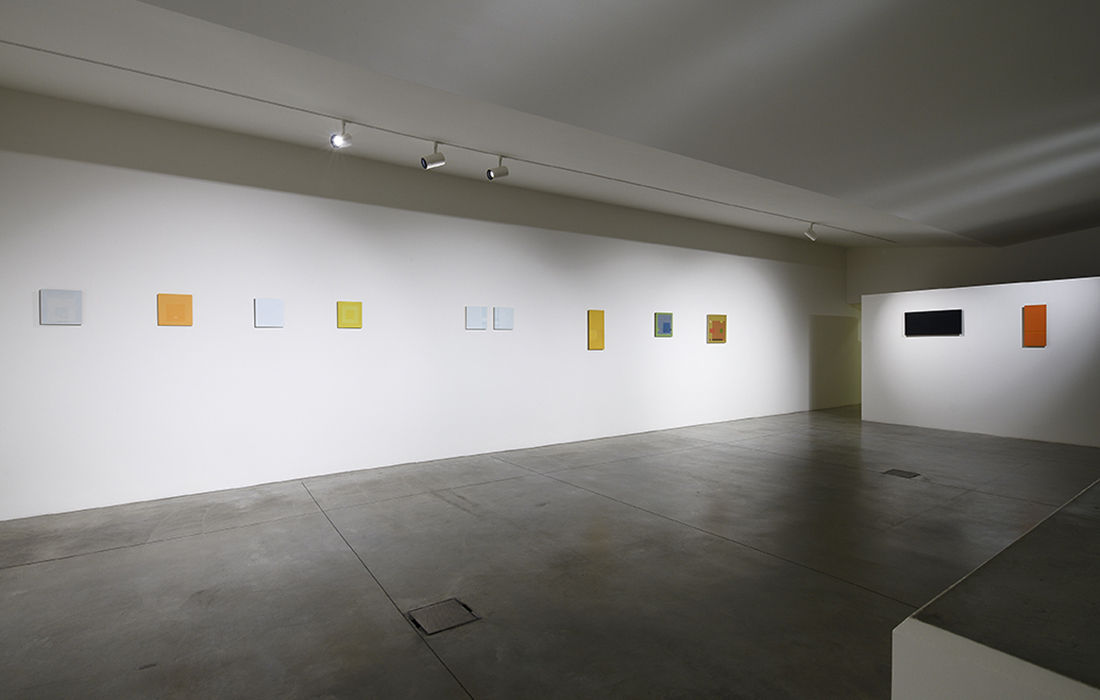January – February 2016
Space, light. Silence
by Serge Lemoine
To summarise: the painter Antonio Calderara devoted his life to the representation of space, the translation of light and the expression of silence, all with the utmost discretion. Calderara carried out his work in the north of Italy, his homeland, a world of Alpine mountains and vast lakes. He lived a secluded life with his wife Carmela, surrounded by his family, in Vacciago, on the banks of lake Orta. It is to this lake that he owes everything. Tirelessly, he represented the light of its landscapes throughout the changing seasons. His creations, profound, secret and intimate, were created by him in small format and were not widely known. Calderara was never famous. We can count a small number of connoisseurs, most of whom are artists, as his fans. He was initially discovered by painters, the first of which was Almir Mavignier. Like Max Bill, Jesús-Raphael Soto, François Morellet and Reimer Jochims, they admired his work and the man himself once they had met him and Calderara extended his friendship to them in return. He also had the support of some art critics and art historians, among them Friedrich Heckmanns, Carlo Belloli, Jean Leering and Bernhard Holeczek. Of course, he exhibited his work in his own country, but most often in Germany and the Netherlands, in galleries, museums, and once, and perhaps most importantly, with twelve works, at Documenta in Cassel in 1968. Indeed, there are very few works available to act as testament to this unique, demanding art, reserved but perfectly accomplished. Calderara was certainly a great painter. So, let us explore some of the significant elements of his creative production and career.
Uniqueness
Antonio Calderara is known today for his paintings that belong to the geometric abstraction movement. They have all of its key features: simple forms, use of right angles, space without depth, flat blocks of colour. A limited vocabulary of lines and squares, a restricted palette of colours, a rigorous composition based on measurement: we are very much dealing with concrete art. But the structures that give birth to these well-organised spaces, the colours that express this bright and enveloping kind of light are truly unique to Calderara’s work. He only began to create these distinctive paintings in later years, when he was already 56 years old. Up until then he had remained a figurative painter, progressively abandoning figures for landscape and never ceasing to simplify his vision. Nothing however, that would allow us to imagine the nature of his beginnings.
Antonio Calderara was born in 1903. After a youth characterised by impressionism and realism, the landscapes and “silent lives” of Alberto Morandi left a mark on Antonio Calderara, as did the work of several painters from the “Magic Realism” movement that emerged in Italy in the 1920s and 30s following the metaphysical paintings of Giorgio de Chirico and Carlo Carrá. Here we can catch a glimpse of how unique his development was: a provincial Italian painter, representing his family and his country, faithful to his values and secluded for a long time, who, through reflection and perseverance but without ever abandoning his sensitivity, became a fantastic abstract painter renowned in his community and eventually worldwide.
Disparity
Calderara’s beginnings are astonishing but at the same time pre-empt what would follow: landscapes, some urban scenes, figures alone or in groups, some rare still lifes that bear witness to his participation in the Magic Realism movement, a group that emerged in Italy at around the same time as the Neue Sachlichkeit movement in Germany. The 1928 painting Bridge on Rue Chiusa in Milan which could easily be German, his Portrait of my Wife from 1934 and his full-length figure entitled Bianco-Rosso from the same year are characteristic of this trend and can be compared to the work of Felice Casorati in their composition, their stylised forms and their taste for reduced-down drawing. The Window and The Book from 1935 already reveal Calderara’s entire universe through its construction of space, stylisation of contours, restricted colour range, contrasts in lighting and even the subject matter itself: we see an intimate scene inside and the calm of the landscape outside brought together via an open window. On the window ledge protrudes the silhouette of a cactus made of endless curves.
His group painting from 1934 The Family. After the Storm, presents all of the same characteristics; the artist insisted more on light while painting the foreground and far distance and created the tranquillity and silence which perfectly capture the atmosphere of his homeland and lake Orta. In the 1940s and the early 1950s, the next step was a logical one: his universe closes in, the figures progressively disappear, forms are simplified and gradually fade away, the monochrome takes hold, and light takes precedence over the whole, as in the figure painting Nude from 1944, the still life White Flowers from 1952 and the landscape Winter from 1951-1952.
Everything is ready for the last stage of his progression: this happened relatively quickly compared to the length of the preceding cycles, occupying the years 1957, 1958 and 1959. The artist abandoned the human figure and other subjects to focus on landscape. He favoured several sites around lake Orta and in the town of Vacciago where he lived. He simplified the elements and architecture of the landscape by reducing them to just a few horizontal and vertical lines that he arranged on the plane. The creative process of these compositions was almost identical to the one used by Piet Mondrian, whose work he discovered in 1954. Mondrian made a clear impact on Calderara, and we must tie him to the new language created by Theo van Doesburg and Bart van der Leck in the Netherlands between 1914 and 1919. The successive stages used by van der Leck in 1917 to create his his painting Composition 1917- 4. Leaving the Factory (Otterlo, Kröller-Müller Museum) are those that in turn Calderara himself would use in The History of Lake Orta. 18 variations on a theme which he painted in 1976 as a display based on watercolour. To these elementary forms, he added his own vocabulary of colours, those which translated the damp light of his homeland and the misty haze which blurred the shapes: a range of very light blues, one or two greenish yellows (Painting, 1957), some very light greys with a few strains that come close to pink or violet (Light Colours, 1959) and applied in flat blocks of colour. We imagine rather than actually make out a dock, a pontoon, a wall, some water and the other river bank with its outline of a church or a mountain, but these are just planes of colour in a completely vertical composition, without any depth at all. His 1959 painting Landscape (Francfort-sur-le-Main, private collection) pushes the idea of simplification further still. It is made up of 4 rectangles laid out inside a horizontal rectangular format: 3 are parallel horizontal bands with a vertical band on the right. We can gather that this is a river bank, some water, part of the sky and a section of a wall. The patterns have disappeared in this transposition. All that remains is the essential: the structure and the range of softened colours, which try to blend into one another to the benefit of the translation of the light. In 1959, he took the plunge. Calderara painted his first abstract painting which drew its inspiration from reality and from observation, but no longer really represented it. Geometric abstraction provided him with a “mental space”. The works were now entitled Light Space, Vertical Progression (1959-1960), Counterpoint for Vertical Rythms-Hommage to Erik Satie (1960, Munich, both works in private collections), Vertical Tensions (1966) or furthermore Constellations (1968, both works in private collections). Here all artistic intentions are given over to the compositions, the relationship between the horizontal and the vertical, symmetry or asymmetry, progression or repetition, the contrast between forms, monochrome, the tonal values which come together inexpressibly and which bring the unique light that bathes the views over lake Orta to life. Up until his death in 1978, Calderara devoted himself to this art form1 which he only reached in his twilight years and which was truly his greatest achievement.
Methods
Antonio Calderara used very specific techniques to express his unusual sensitivity and which made his works instantly recognizable: format, medium, support, craftsmanship, the colour of course and finally the way in which the work was presented. His formats are, apart from some rare exceptions, small in size, square, measuring for example 27 x 27 cm or often rectangular and horizontal, 25.6 x 36 cm for example, an appropriate format for landscapes and seascapes. Some of them are also vertical and very narrow, 27cm high and 3 cm wide. A few are presented as panel paintings, such as Horizon (1968-1970) which is made up of 7 panels each measuring 54 x 18 cm.
Calderara worked with oil paint on canvas, generally on wooden panels rubbed down and primed, but he alternated with watercolour on paper which was perfect for capturing the subtleties of transparency. In his oil paintings, the handling is smooth, without any apparent brushstrokes, the finish lacquered and satiny; the watercolours are washed and their treatment uniform. The colours are applied in flat blocks, without variation in the oil paint or watercolours. The finished work is always presented fixed onto an overflowing support, on the inside of a white box protected by glass2: a way for the artist to emphasize the rare and precious nature of his works.3
Calderara used a very limited number of forms: squares, rectangles, dashes of varying length, thick and spaced-out, wide or thin lines. These elements are always juxtaposed, that is to say, they are not superimposed over each other, and set out inside an orthogonal grid strictly placed in the composition: they express rhythm and structure. At the same time colour is used to fill the surfaces: always subdued, as we have seen and playing on intertwined nuances, not unlike the effects of monochrome painting with its dominant shades of white, blue, yellow, red or pale greys. This fully simplified structure, this virtual absence of colour, these interconnected tonal values, this overall equalisation and the reduced format all require our undivided attention in order for its components to be perceived. The ensemble is entirely at the mercy of the translation of the light, this light which is so unusual, misty, enveloping, iridescent, which was his source of inspiration and which he never ceased to want to capture throughout the passing days and seasons.
Opening
It is hard to imagine a more restricted theme or work that is as discrete. There is none of the brightness of a Fontana, nor the force of a Burri, none of the lyricism of Dorazio nor the liveliness of Vedova, to not stray from the Peninsula with these famous names. Calderara was not present in post-war Italy when everything was called into question. The events that turned his country, Europe, the whole planet upside down do not leave their mark on his work. His world is elsewhere, he belongs to a different time, which falls into the long term. Calderara only began to reveal himself from 1960 onwards. He was 57 years old. We began to discover his abstract works, little by little, after an exhibition organized by Almir Mavignier in Germany, that nevertheless remained a secret.4 From this point on, Calderara was brought into the international art world. His works were abstract, geometric, carefully developed, highly simplified, almost monochrome, carried out in a neutral manner. Calderara became part of the concrete art movement that had re-emerged in full vigour: he had already been part of the Max Bill exhibition konkrete kunst presented in 1960 at the Helmhaus in Zurich; in 1972 he found himself in Bochum at the m gallery in the company of Enrico Castellani, Ad Dekkers, Jan Schoonhoven, herman de vries, Gerhard von Graevenitz, Günther Uecker and François Morellet in an exhibition called Neue Konkrete Kunst. His work was not so different from those by artists from the Nouvelles Tendances who Almir Mavignier had reunited for the first time in 1961 in Zagreb.5Calderara was also part of the Weiss auf Weiss exhibition organised by Harald Szeemann in 1966 at the Kunsthalle in Berne. Max Bill and Richard Paul Lohse saw him as one of their own. His compositions can also be compared to those by Josef Albers with whom he shared the same concern for proportion and a desire to translate light through colour. His colourful palette, his taste for lines and dashes, but also the same refinement can be found in paintings by Friedrich Vordemberge-Gildewart. The use of grids, compositions made up of concentric squares, the colour and contrasts that disappear into the brightness of the white is also found in the work of Aurelie Nemours. The works using minute nuances of white and light greys painted by François Morellet in particular during the early 1950s, his compositions where subtle variations of yellow dominate, his experimentations with red served to create a link between the two artists as well as the friendship that would follow.6 Over a short period of time, during the 1960s, Calderara, who up until that time had remained virtually secluded, found a family at the heart of which his work took on all its true meaning.
This family, this community of spirit and sensibility was not restricted to Europe. It found its equivalent in America in the work of Agnes Martin, whose greatest achievements also came later in life. The repetitive formulas, the importance of horizontality, the representation of imperceptible nuances are common factors in the work of both artists, to a point where their works could be superimposed or hung in pairs, notwithstanding their differences in format. Small on the one hand, large on the other, but dealing with the same thing, the same inspiration, an identical approach and a similar result. It may seem surprising, but the same comparison can be made between the work of Antonio Calderara and that of another great American painter, Kenneth Noland. His horizontal paintings, so long and narrow, around 15 cm high and nearly 243 cm long for example, painted during the 1960s, his compositions made up of parallel strips of alternating colour that emanate rhythm and express time, are nothing more than river banks, flowing water, stretches of land, skies and horizons. An abstract artist, Noland painted landscapes in the style of Calderara during his abstract period, as can be seen in the painting Enisle by the American made in 1969 (David Mirvish Collection, Toronto) and Space Colour Light, Pink-Blue, painted by the Italian in 1975.
In just one swoop, nothing but correspondences, changes and prospects: Calderara had found his place, but his song remained unique because he expresses a changing atmosphere, a light that balances everything out. He represented an immutable and peaceful order, where silence reigns. And if there was one final comparison to be made then it would be with the paintings of Vilhelm Hammershøi. Through its origins, from its beginnings and by its development, Antonio Calderara’s art has managed, whilst becoming more and more abstract, to remain universal and to continue translating the world.
Notes
1 At the end of his life, Antonio Calderara, exhausted by illness, partly committed himself to a slightly different approach to the one he had followed since 1960 by looking for new motifs which he found in the letters of the alphabet. He created, in this way, inscriptions from horizontal, vertical and even oblique sticks, which were not legible but which formed a new language made of signs laid out as if on a scroll at the centre of a table. These works are entitled Letter from a Convalescent.
2 Antonio Calderara liked to exchange works with all of the artists he appreciated. This allowed him to build an elite and highly original collection, wholly devoted to abstraction. Indeed all of these works were chosen according to their identical format to that of his own works and framed in exactly the same way. They are on permanent exhibition at the Calderara Foundation in Vacciago.
3 The same for Paul Klee and Kurt Schwitters in particular, for whom the mounting and the presentation of the work with their inscriptions, title, numbering, signature was part of the work itself.
4 As he himself pointed out to us, Almir Mavignier went to Milan in 1959 for the exhibition by the Stringenz nuove tendenze tedesche group, held at the Pagani del Grattacielo gallery and in which he participated. It was on this occasion that he discovered Calderara’s work, whom he visited shortly after at his studio in Milan and then in Vacciago. He was highly impressed by the “work equally naturalist and abstract in nature” he saw there. On his return to Germany, Almir Mavignier suggested to Kurt Fried that he organise a Calderara exhibition at his gallery, Studio f in Ulm, the town home to the University of Art and Design. In order to convince him, Mavignier had brought two of Calderara’s works with him. The exhibition opened in 1960. The two works in question are today kept in the Kunstmuseum in Ulm as part of a donation that Kurt Fried made from his private collection.
5 On this point, see Serge Lemoine, “Almir Mavignier Nove Tendencije” in The Artist as Curator Collaboratives Initiatives in the International Zero Movement 1957-1967, under the direction of Tiziana Caianiello, Mattijs Visser, Zero Foundation, volume 5, Düsseldorf and Gent, 2015, pp. 292-301.
6 François Morellet, who often exhibited in Italy, first met Antonio Calderara in 1970. He visited him in Vacciago. His two paintings, Blue Yellow Red from 1952 and 3 Superpositions from 1975, the result of an exchange and framed like Calderara’s works, can today be found at the Antonio and Carmela Calderara Foundation.


